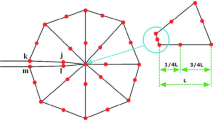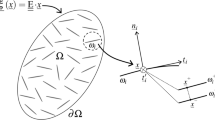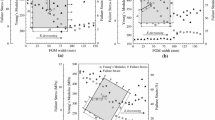Abstract
Different aspects of thermomechanical fracture of functionally graded materials (FGMs) are considered. Among them are the crack interaction problems in a functionally graded coating on a homogeneous substrate (FGM/H). The interaction between systems of edge cracks is investigated, as well as, how this mutual interaction influences the fracture process and the formation of crack patterns. The problem is formulated with respect to singular integral equations which are referred to the boundary equation methods. The FGM properties are modeled by exponential functions. The main fracture characteristics are calculated, namely, the stress intensity factors, the angles of deviation of the cracks from their initial propagation direction and the critical stresses when the crack starts to propagate. The last two characteristics are calculated using an appropriate fracture criterion. The problem contains different parameters, such as the geometry (location and orientation of cracks, their lengths, and the width of the FGM layer) and material parameters, i.e. the inhomogeneity parameters of elastic and thermal coefficients of the functionally graded material. The influence of these parameters on the thermo-mechanical fracture of FGM/H is investigated. As examples the following real material combinations are discussed: TiC/SiC, Al2O3/MoSi2, MoSi2/SiC, ZrO2/nickel and ZrO2/steel.
Similar content being viewed by others
References
Jha, D.K., Kant, T., and Singh, R.K., A Critical Review of Recent Research on Functionally Graded Plates, Compos. Struct, 2013, vol. 96, pp. 833–849.
Miyamoto, Y., Kaysser, W.A., Rabin, B.H., Kawasaki, A., and Ford, R.G., Functionally Graded Materials: Design, Processing and Applications, Dordrecht: Kluwer Academic, 1999.
Schulz, U., Peters, M., Bach, Fr.-W., and Tegeder, G., Graded Coatings for Thermal, Wear and Corrosion Barriers, Mat. Sci. Eng. A, 2003, vol. 362, pp. 61–80.
Kawasaki, A. and Watanabe, R., Thermal Fracture Behavior of Metal/Ceramic Functionally Graded Materials, Eng. Fract. Mech., 2002, vol. 69, pp. 1713–1728.
Rangaraj, S. and Kokini, K., Multiple Surface Cracking and its Effect on Interface Cracks in Functionally Graded Thermal Barrier Coatings under Thermal Shock, J. Appl. Mech. Trans. ASME, 2003, vol. 70, pp. 234–245.
Gilbert, A., Kokini, K., and Sankarasubramanian S., Thermal Fracture of Zirconia-Mullite Composite Thermal Barrier Coatings under Thermal Shock: An Experimental Study, Surf. Coat. Tech., 2008, vol. 202, no. 10, pp. 2152–2161.
Zhou, B. and Kokini, K., Effect of Surface Pre-Crack Morphology on the Fracture of Thermal Barrier Coatings under Thermal Shock, Acta Mater., 2004, vol. 52, pp. 4189–4197.
Feng, Y.Z. and Jin, Z.-H., Thermal Shock Damage and Residual Strength Behavior of a Functionally Graded Plate with Surface Cracks Alternating Length, J. Therm. Stresses, 2012, vol. 35, pp. 30–47.
Petrova, V. and Schmauder, S., Thermal Fracture of a Functionally Graded/Homogeneous Bimaterial with a System of Cracks, Theor. Appl. Fract. Mech., 2011, vol. 55, pp. 148–157.
Petrova, V. and Schmauder, S., Mathematical Modelling and Thermal Stress Intensity Factors Evaluation for an Interface Crack in the Presence of a System of Cracks in Functionally Graded/Homogeneous Bimaterials, Comp. Mater. Sci., 2012, vol. 52, pp. 171–177.
Petrova, V. and Schmauder, S., Interaction of a System of Cracks with an Interface Crack in Functionally Graded/ Homogeneous Bimaterials under Thermo-Mechanical Loading, Comp. Mater. Sci., 2012, vol. 64, pp. 229–233.
Petrova, V. and Schmauder, S., FGM/Homogeneous Bimaterials with Systems of Cracks under Thermo-Mechanical Loading: Analysis by Fracture Criteria, Eng. Fract. Mech., 2014, vol. 130, pp. 12–20.
Petrova, V. and Schmauder, S., Crack Closure Effects in Thermal Fracture of Functionally Graded/Homogeneous Bimaterials with Systems of Cracks, ZAMM, 2015, vol. 95, no. 10, pp. 1027–1036.
Petrova, V. and Sadowski, T., Theoretical Modeling and Analysis of Thermal Fracture of Semi-Infinite Functionally Graded Materials with Edge Cracks, Meccanica, 2014, vol. 49, pp. 2603–2615.
Afsar, A.M. and Sekine, H., Crack Spacing Effect on the Brittle Fracture Characteristics of Semi-Infinite Functionally Graded Materials with Periodic Edge Cracks, Int. J. Fracture, 2000, vol. 102, pp. L61–L66.
Sekine, H. and Afsar, A.M., Composition Profile for Improving the Brittle Fracture Characteristics in Semi-Infinite Functionally Graded Materials, JSME Int. J. A, 1999, vol. 42, no. 4, pp. 592–600.
Kokini, K., DeJonge, J., Rangaraj, S., and Beardsley, B., Thermal Shock of Functionally Graded Thermal Barrier Coatings with Similar Thermal Resistance, Surf. Coat. Tech., 2002, vol. 154, pp. 223–231.
Shackelford, J.F. and Alexander, CRC Materials Science and Engineering Handbook, Boca Raton: CRC Press, 2001.
Panasyuk, V., Savruk, M., and Datsyshin, A., Stress Distribution near Cracks in Plates and Shells, Kiev: Naukova Dumka, 1976.
Savruk, M.P., Two-Dimensional Problems of Elasticity for Body with Cracks, Kiev: Naukova Dumka, 1981.
Erdogan, F. and Gupta, G., On the Numerical Solution of Singular Integral Equations, Quart. Appl. Math., 1972, vol. 29, pp. 525–534.
Kalandia, A.I., Mathematical Methods of Two-Dimensional Elasticity, Moscow: Nauka, 1973.
Erdogan, F. and Sih, G.C., On the Crack Extension in Plates under Plane Loading and Transverse Shear, J. Basic Eng., 1963, vol. 85, pp. 519–527.
Petrova, V., Schmauder, S., and Shashkin, A., Modeling of Edge Cracks Interaction, Fract. Struct. Int., 2016, vol. 36, pp. 8–26.
Cortet, P.-P., Huillard, G., Vanel, L., and Ciliberto, S., Attractive and Repulsive Cracks in a Heterogeneous Material, J. Stat. Mech. Theor. Exp., 2008, vol. 10, P10022(12 p).
Author information
Authors and Affiliations
Corresponding author
Additional information
Original Text © V.E. Petrova, S. Schmauder, 2017, published in Fizicheskaya Mezomekhanika, 2017, Vol. 20, No. 3, pp. 5–12.
Rights and permissions
About this article
Cite this article
Petrova, V.E., Schmauder, S. Modeling of thermomechanical fracture of functionally graded materials with respect to multiple crack interaction. Phys Mesomech 20, 241–249 (2017). https://doi.org/10.1134/S1029959917030018
Received:
Published:
Issue Date:
DOI: https://doi.org/10.1134/S1029959917030018




